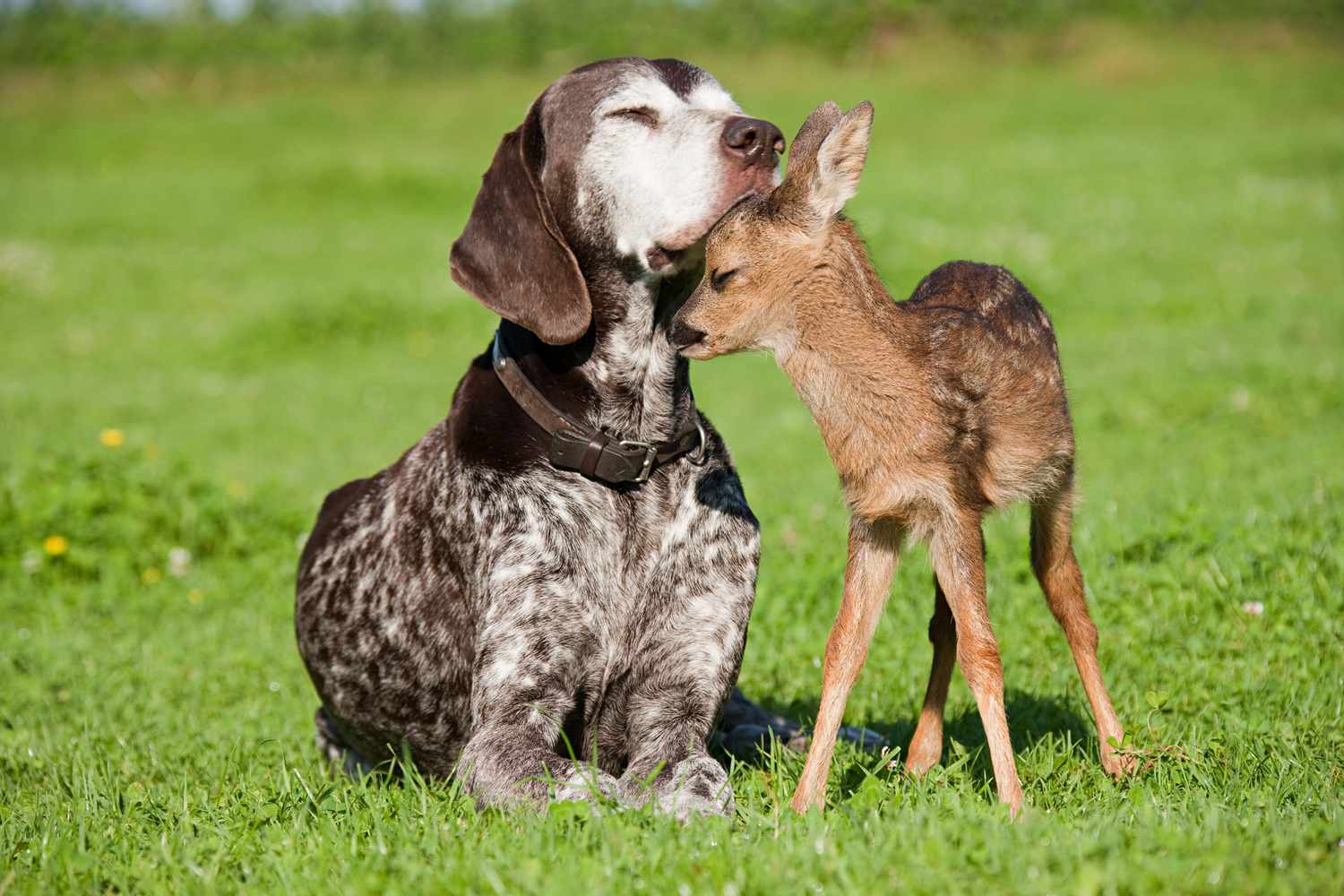
Ever wondered how a dog and an orangutan could become best friends? Unusual animal partnerships have always intrigued us, revealing the surprising ways different species interact. From a jaguar and a Jack Russell terrier growing up together to a mother cat adopting ducklings, these heartwarming stories showcase the adaptability and resilience of animals. Such partnerships not only capture our imagination but also offer insights into animal behavior, social learning, and communication. By exploring these unique bonds, we gain a deeper appreciation for the natural world and its diverse inhabitants. Ready to dive into the world of extraordinary animal friendships? Let's explore 50 fascinating facts about these remarkable relationships.
Fascinating Animal Behaviors
Animals often surprise us with their unique behaviors and adaptations. These fascinating facts highlight some of the most intriguing aspects of the animal kingdom.
-
Roosters and Their Ear-Plugging Mechanism: Roosters crow loudly, reaching over 100 decibels. To protect their hearing, they tilt their heads back, covering their ear canals.
-
Giant Squid: The Elusive Giant: The largest giant squid found measured over 50 feet and weighed nearly a tonne. Despite its size, much about this creature remains unknown.
-
Pangolin's Armor Plated Ball: Pangolins roll into a ball to protect themselves from predators. Unfortunately, this defense makes them easy targets for poachers.
-
Koalas' Long Sleep: Koalas sleep up to 22 hours daily due to their low-nutrition eucalyptus diet, which requires significant energy to digest.
-
Swifts' Non-Stop Flight: Swifts can fly for almost a year without landing. One study showed a swift stopping for just two hours over ten months.
Unusual Animal Friendships
Some animals form unexpected bonds with other species, showcasing their ability to connect and adapt in surprising ways.
-
Cats and Ducklings: A mother cat adopted ducklings, nurturing them alongside her kittens and even allowing them to drink her milk.
-
Jaguar and Jack Russell: A jaguar and a Jack Russell terrier, raised together, refused to separate, continuing to eat, sleep, and play together.
-
Husky and Polar Bear: In Canada, polar bears and huskies were seen playing together, with the bears choosing play over predation.
-
Rhino and Sheep: An orphaned rhino calf learned to graze and de-stress by being paired with a sheep.
-
Lion and Oryx: A lioness in Kenya cared for a newborn oryx, likely due to past trauma, despite the fate of previous oryxes.
Unique Animal Adaptations
Animals have evolved remarkable adaptations to survive and thrive in their environments.
-
Yak's High Altitude Adaptation: Yaks, native to Tibet, have large lung capacities and small red blood cells, enabling them to live at high altitudes.
-
Koala Fingerprints: Koalas have fingerprints almost indistinguishable from humans, aiding in grasping eucalyptus leaves.
-
Whale Shark's Vision: Whale sharks have denticles around their iris and can retract their eyes, suggesting vision is more important than previously thought.
-
Embryonic Diapause: Some animals, like mice and seals, can pause pregnancies for days to months, adapting to environmental conditions.
-
Tammar Wallaby’s Pause: The tammar wallaby can pause pregnancies during food scarcity, ensuring offspring survival when conditions improve.
Social and Emotional Behaviors
Animals exhibit complex social and emotional behaviors, often mirroring human traits.
-
Elephants' Mourning: Elephants mourn their dead, returning to the site of a family member's death and standing in silence over the bones.
-
Meerkat Parenting: Meerkat parents train their young to hunt scorpions by bringing back dead or nearly dead ones for practice.
-
Rats’ Laughter: Rats giggle when tickled, showcasing their playful nature and ability to experience joy.
-
Norway’s Penguin Knighthood: Norway knighted a penguin, highlighting the special place penguins hold in human appreciation.
-
Parrot Pandemonium: A group of parrots is called a pandemonium, reflecting their noisy and lively nature.
Conservation and Legal Protections
Understanding animal behaviors and needs can lead to better conservation efforts and legal protections.
-
Guinea Pig Social Rights: In Switzerland, it is illegal to own just one guinea pig, ensuring they have companionship.
-
Goldfish Social Rights: Swiss law also prohibits keeping goldfish alone, recognizing their need for social interaction.
-
Cat Window Access: Swiss cats must have window access to see other felines, preventing isolation.
-
Dog Training Course: Switzerland once required dog owners to take a training course with their pets, emphasizing the importance of socialization.
-
Conservation Efforts: Studying unusual animal partnerships can inform conservation efforts, promoting better welfare in captivity.
Remarkable Animal Facts
These facts showcase the incredible diversity and adaptability of the animal kingdom.
-
Cockroach's Head Survival: Cockroaches can live for weeks without their heads, and the head can survive for hours on its own.
-
Cows' Manure Production: Cows produce up to 115 pounds of manure daily, used as fertilizer, fuel, or biogas.
-
Snail's 14,000 Teeth: Garden snails have 14,000 teeth arranged in rows on their radula, with some species having over 20,000.
-
Cuckoo Birds' Egg Hiding: Cuckoo birds lay eggs in other species' nests, leaving the host bird to raise their chicks.
-
Early Depictions of Dogs: The earliest depictions of dogs, dating back 8,000 years, show a man hunting with 13 dogs in Saudi Arabia.
Animal Communication and Learning
Animals communicate and learn in diverse ways, often forming bonds and adapting behaviors from other species.
-
Scientific Interest in Animal Friendships: Scientists study unusual animal friendships to understand interspecies communication and behavior adoption.
-
Dog and Orangutan: Orangutans treated a stray dog named Rosco as a pet, feeding and caring for him.
-
Antelope and Giraffe: A male antelope and a female giraffe formed a bond in a safari park, even attempting to mate.
-
Bear, Tiger, and Lion: An American black bear, a tiger, and a lion lived together in a wildlife sanctuary, playing and sleeping together.
-
Bulldog and Lion Cub: Raised together in a safari park, a bulldog and a lion cub formed a close bond, playing all day.
Evolutionary Adaptations and Unique Traits
Animals have evolved unique traits and behaviors to survive and thrive in their environments.
-
Platypus and Echidna: The platypus and echidna are the only egg-laying mammals, blending reptilian and mammalian characteristics.
-
Bat Love Songs: Brazilian free-tailed bats sing nuanced love songs, showcasing complex animal communication.
-
Swifts' Non-Stop Flight: Swifts can fly for almost a year without landing, demonstrating incredible endurance.
-
Yak's High Altitude Adaptation: Yaks have large lung capacities and small red blood cells, allowing them to live at high altitudes.
-
Koala Fingerprints: Koalas' fingerprints are almost indistinguishable from humans, aiding in grasping eucalyptus leaves.
Unusual Animal Partnerships in the Wild
These partnerships highlight the adaptability and resilience of animals in the wild.
-
Capybara and Puppies: A capybara in a wildlife refuge acted as an adopted mother for several litters of puppies.
-
Rhino and Sheep: An orphaned rhino calf learned to graze and de-stress by being paired with a sheep.
-
Lion and Oryx: A lioness in Kenya cared for a newborn oryx, likely due to past trauma, despite the fate of previous oryxes.
-
Dog and Orangutan: Orangutans treated a stray dog named Rosco as a pet, feeding and caring for him.
-
Antelope and Giraffe: A male antelope and a female giraffe formed a bond in a safari park, even attempting to mate.
Insights from Unusual Animal Partnerships
Studying these partnerships provides valuable insights into animal behavior, communication, and social learning.
-
Social Learning: Meerkat parents train their young to hunt scorpions by bringing back dead or nearly dead ones for practice.
-
Adaptation to Environment: Yaks are specially adapted to high altitudes with large lung capacities and small red blood cells.
-
Evolutionary Adaptations: Koalas' fingerprints are almost indistinguishable from humans, aiding in grasping eucalyptus leaves.
-
Conservation Efforts: Understanding unusual animal partnerships can inform conservation efforts, promoting better welfare in captivity.
-
Public Interest and Education: Videos of unlikely animal friendships capture public imagination, promoting education and awareness about animal behavior and welfare.
The Fascinating World of Animal Friendships
Unusual animal partnerships offer a peek into the complex social behaviors of various species. These interactions highlight adaptability, resilience, and unique traits that make each species special. From roosters with built-in ear-plugs to koalas with human-like fingerprints, these facts showcase the incredible diversity of the animal kingdom. Understanding these partnerships can inform conservation efforts, ensuring better care for animals in captivity and the wild. Videos of these friendships have captured public interest, promoting education and awareness about animal behavior. By studying these bonds, we gain insights into how species communicate, learn, and adapt. These partnerships remind us of the interconnectedness of life on Earth and the importance of preserving it. So next time you see a video of a dog playing with an orangutan or a cat adopting ducklings, remember there's more to these friendships than meets the eye.
Was this page helpful?
Our commitment to delivering trustworthy and engaging content is at the heart of what we do. Each fact on our site is contributed by real users like you, bringing a wealth of diverse insights and information. To ensure the highest standards of accuracy and reliability, our dedicated editors meticulously review each submission. This process guarantees that the facts we share are not only fascinating but also credible. Trust in our commitment to quality and authenticity as you explore and learn with us.


